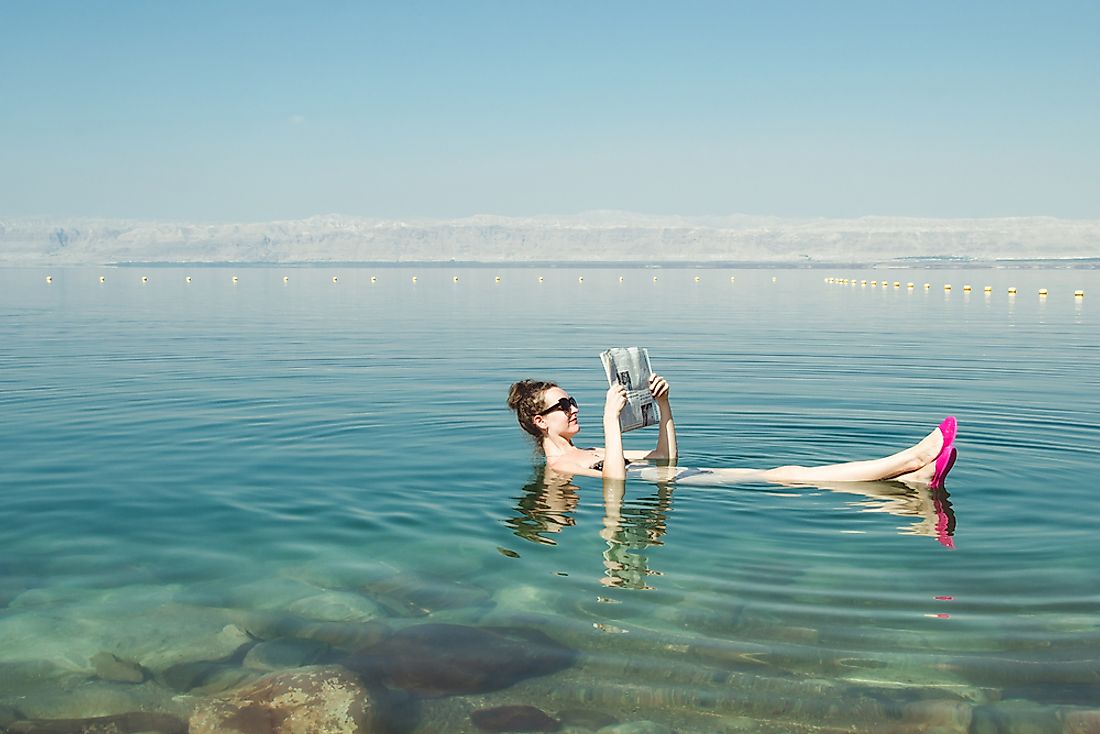The World's Saltiest Bodies of Water

The Don Juan Pond is a small and very shallow hypersaline lake located in Antarctica and has a salinity of 44%. The pond, despite being situated in one of the coldest places on Earth does not freeze due to the salination levels. Lake Vanda, also located in Antarctica has a salinity of 35%. Other saline bodies of water include the Dead Sea, shared between Israel, Jordan and Palestine; Great Salt Lake, Mono Lake, and Salton Sea in the US, and Europe’s Baltic Sea.
What Is A Hypersaline Body Of Water?
A hypersaline body of water contains higher saline levels than that of oceans. The salinity is caused by the concentration of sodium chloride or other salts. These bodies of water lack outputs, meaning that they lose water only through evaporation, a process which leaves mineral salts behind. Some of these bodies of water such as Lake Assal in Djibouti are commercially valuable due to the salt concentrations. The hypersaline bodies of water have great buoyancy as a result of high salinity levels.
The Salinity Of The Oceans Of The World
Oceans have a 3.5% salinity which is modest compared to some of the world’s saline bodies of water. Sea water is home to numerous chemicals which render it salty. These chemicals originate from rocks and soil which dissolve in the rivers feeding the oceans. The salinity of the ocean is not evenly distributed as some regions have higher levels than other. Parts of the ocean which experience lots of evaporation tend to be more saline and denser. Areas of the ocean which receive a lot of rain or close to the land tend to be less saline as the freshwater dilute the salts.
The Don Juan Pond, The Most Saline Body Of Water
The Don Juan Pond lies nestled in the McMurdo Dry Valleys in Antarctica. At 44% salinity, the Pond has 12 times more salinity levels than that found in oceans. Its salinity levels enable it to remain liquid even at temperatures below -50 degrees Celsius. The Pond relies on fresh water from melted snow to dilute its salt concentration. The Don Juan Pond is a small body of water, occupying a mere 0.03 km2 of surface area.
The Dead Sea: The Deepest Hypersaline Body Of Water
The Middle East is home to the Dead Sea, a famous lake named for the absence of lifeforms. Only bacteria thrive in the lake, and its mud, which contains high concentrations of minerals, is popular for cosmetic and therapeutic purposes. The Dead Sea’s shores and surface are 430.5 meters below sea level, and it takes the crown as the lowest elevation on land. The Dead Sea is renowned for its buoyancy which makes people float and consequently attracts lots of visitors.
Consequences Of High Water Salinity
High water salinity negatively impacts agricultural production in cases where water is used for irrigation. High salt concentrations in soil water cause water to flow from the roots of the plants back to the ground, causing dehydration to the plants. Some salts are also poisonous to plants. In places where people consume water with high salinity levels, they are rendered vulnerable to severe health effects such as hypertension.
What Species Live In Hypersaline Waters?
Hypersaline waters support little life; mainly halophiles adapted to the saline environment. The waters are home to abundant bacteria, fungi and archaea microorganisms. The waters also support fish species such as copepod species as well as some algae species.
The World's Most Saline Bodies Of Water
| Rank | Salinity (percentage) | Name | Type | Region or countries |
|---|---|---|---|---|
| 1 | 44% | Don Juan Pond | Salt lake | Antarctica |
| 2 | 40% | Lake Retba | Salt lake | Senegal |
| 3 | 35% | Lake Vanda | Salt lake | Antarctica |
| 4 | 35% | Garabogazköl | Lagoon | Turkmenistan |
| 5 | 34.8% | Lake Assal | Salt lake | Djibouti |
| 6 | 33.7% | Dead Sea | Salt lake | Israel, Jordan, Palestine |
| 7 | 18% | Little Manitou Lake | Salt lake | Canada |
| 8 | 8.5–28% | Lake Urmia | Salt lake | Iran |
| 9 | 5–28% | Laguna Cejar | Salt lake | Chile |
| 10 | 5–27% | Great Salt Lake | Salt lake | United States |
| 11 | 5–9.9% | Mono Lake | Salt lake | United States |
| 12 | 4.4% | Salton Sea | Salt lake | United States |
| 13 | 3.6-4.1% | Red Sea | Mediterranean sea | Saudi Arabia, Yemen, Egypt, Sudan, Eritrea, Djibouti, Israel, Jordan |
| 14 | 3.5% | Pacific Ocean | Ocean | |
| 15 | 3.5% | Atlantic Ocean | Ocean | |
| 16 | 3–4% | Lake Natron | Salt lake | Tanzania |
| 17 | 2.4% | Lake Van | Salt lake | Turkey |
| 18 | 1.3–2.3% | Black Sea | Mediterranean sea | Bulgaria, Romania, Ukraine Russia, Georgia, Turkey |
| 19 | 1.25% | Caspian Sea | Lake | Azerbaijan, Iran, Kazakhstan Russia, Turkmenistan |
| 20 | 1.0% | Baltic Sea | Mediterranean sea | Europe |
| 21 | 0.013–3.173% | Chilika Lake | Lagoon | India |







